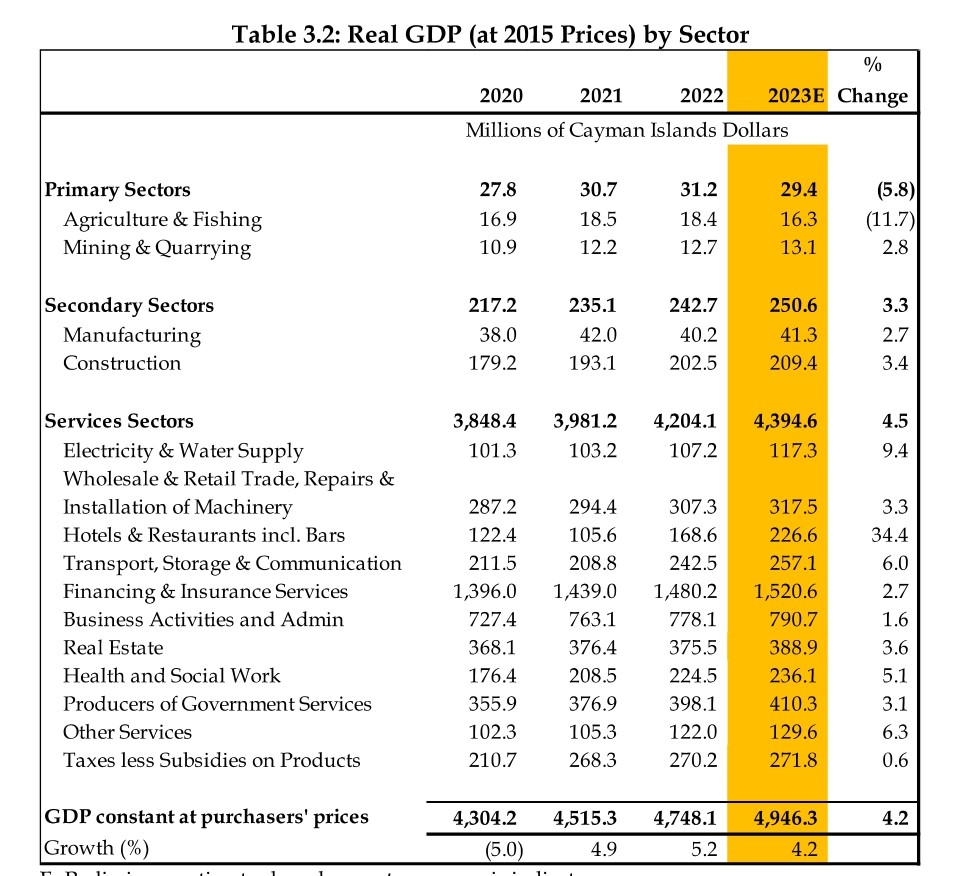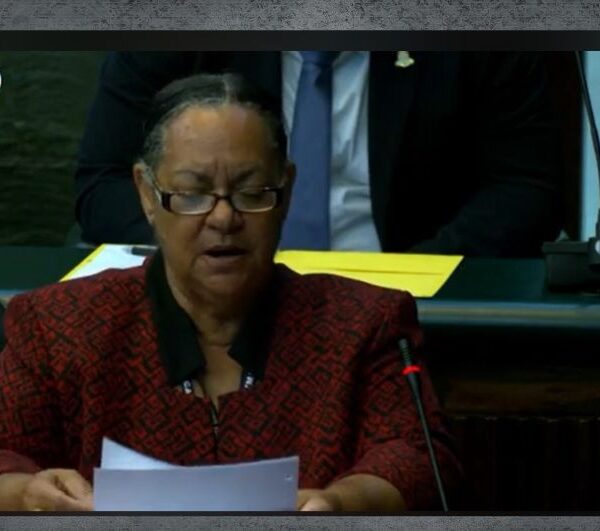
Marla Dukharan
|
Getting your Trinity Audio player ready...
|
By Alric Lindsay
Stakeholders in the Cayman Islands often refer to the financial services, tourism, and construction sectors as “pillars” of the economy. However, there is little discussion about what it truly means for an industry to be a “pillar” and what factors should be considered in making that determination. To gain insight into those factors, such as the sector’s contribution to the real gross domestic product, education, skills, training, and job creation, Blackbox Insights & News met with Caribbean economist Marla Dukharan on August 28, 2024.
First steps: defining an economic pillar
Initiating the conversation, Ms Dukharan shared her approach to defining a pillar.
She said:
Well, I mean, I guess pillar is a label, right? That’s a bit subjective. You’re asking how do you identify a sector that is significant to the economy. That is important, yes, whether you want to call it a pillar [or] whether you want to call it a driver.
I think what you’re trying to ask, what you’re trying to determine is how do you determine a sector that is important?
I would say you would want to think about what are the sectors of the economy that also help to make people’s lives better, and maybe not just one person’s life better, but a proportion of the population that’s significant and material.
Significance of GDP in defining a pillar
When considering whether a sector makes lives better in a material way, stakeholders commonly use gross domestic product as an overall measure.
Notwithstanding that many people are familiar with this approach, Ms Dukharan clarified that gross domestic product is only “a narrow measure of economic activity.”
She explained:
It does not tell you anything about the quality of life. It does not tell you anything about the distribution of the GDP. So, for example, you can have a country like Haiti versus a country like Vanuatu that have roughly the same… GDP per capita.
However, in Haiti, you have a few people who are extremely wealthy. So maybe 1% of the population is extremely wealthy, and so they will control the majority of the GDP for want of a better term, whereas in a country like Vanuatu, it’s much more evenly distributed.
She added: “… if you fixate on GDP only, you will not be telling the whole picture.”
Although Ms Dukharan established that GDP does not tell the whole picture and is a narrow measure of economic activity, it is still worth examining a sector’s GDP contributions to get an indication, even if it is a small one, of how people’s lives were potentially made better.
Looking at the details of Cayman’s GDP sectors, for example, the 2023 Annual Economic Report said that “Actual indicators point to growth across all sectors of the economy except for agriculture & fishing” and “The strong economic performance for the year was largely driven by robust demand for services, which accounted for 88.8 per cent of GDP.”
The breakdown of this 88.8% figure (total GDP of 4,394.6 for the services sectors divided by the GDP of 4,946.3 for all sectors) for the year 2023 is as follows:
- electricity and water supply: 2.37%,
- wholesale & retail trade, repairs: 6.42%
- hotels & restaurants including bars: 4.58%
- transport, storage & communication: 5.20%
- financing and insurance services: 30.7%
- business activities and admin: 15.99%
- real estate: 7.86%
- health and social work: 4.77%
- producers of Government services: 8.30%
- other services: 2.61%.
Other real GDP contributors in 2023 were taxes less subsidies on products, representing 5.50% of real GDP; construction, 4.23% of real GDP; manufacturing, 0.83%; agriculture and fishing, 0.33%; and mining and quarrying, 0.26%.
These 2023 figures, together with other years are set out in the below table:

Notwithstanding that these figures may give a picture of each sector’s contribution to overall GDP, it is important to reiterate that such an analysis does not paint the whole picture.
Instead, a more thorough study is needed to understand how GDP is distributed among the population and who benefits the most from such distribution.
For example, to determine how Caymanians benefit from a sector’s GDP growth, specific information on the number of Caymanians represented in each sector and the proportion of income and wealth they receive from the relevant sector must be gathered.
Looking at the number of Caymanians in each sector
Regarding the number of Caymanians in each industry, the 2022 Compendium of Statistics from the Economics & Statistics Office reflects that Caymanians make up smaller proportions of the total number of people employed across most economic sectors.
To partially explain such proportions, one must appreciate that the Cayman Islands’ labour force grew rapidly in response to increased demands for foreign labour rather than the number of Caymanians growing to take jobs in different sectors.
Elucidating on this unique aspect of Cayman’s labour force reflected in the tourism sector, Ms Dukharan said:
It is mostly expatriate labor that is imported to satisfy the demand for… labour… in this sector.
So, Cayman is unique in that regard.
… the point I’m making is that Cayman did not have to rely on the tourism sector to create jobs for people who no longer wanted to be in agriculture the way other islands did.
And so, the history behind the tourism product and the way that it employs people is different in Cayman as it is in other countries.
She added: “If you did not have this huge demand for labour that has to then be satisfied by expatriate labour, then there would be a much smaller tourism sector that could be more significantly satisfied by local labour.”
Ms Dukharan contrasted the labour composition in Cayman’s tourism sector with that of other Caribbean countries.
She explained:
Well, big countries like Guyana, Suriname, Dominican Republic, Jamaica, they grew all kinds of things. Coffee, cocoa, Trinidad, too. But the dominant crop was sugar. And when, you know, upon independence and that whole independence movement and following the independence movement and the liberation of our people. Liberation, you know, there was this desire to shift away from. From this over dependence on this crop that had all kinds of stigmas and historical. How should I say? Yeah, stigmas, basically.
And, you know, this transition to tourism, I think, was probably very obvious and convenient because, of course, it’s.
We have beautiful vistas, beautiful beaches, you know, where people from all over the world would love to come and spend time here.
And so the tourism product that we already had, which might have been that much more small scale and authentic and community based in, say, the sixties, seventies, you know, then rapidly became more of a mass tourism, tourism model because we then had a labor force that we want to transition out of producing sugar. Right. And so most countries in the Caribbean, that especially in the island economies, their tourism sector absorbed that labor. And it is where the majority of people in many countries in the Caribbean, the majority of people are employed in the tourism sector. So it is a powerful or important job creating sector in many countries in the Caribbean. This is not the case in Cayman because Caymanians are a minority in the tourism workforce.
The importance of locals in other Caribbean countries transitioning from sugar sectors to tourism and other sectors is significant. This reflects the fact that locals in other Caribbean countries were trained or otherwise became skilled or educated to enter different sectors.
Importance of training and education
With education, training, and networking being keys to entering and advancing in any economic sector, it is critical that Cayman’s education system adequately prepares young Caymanians to enter the workforce and that they continue to get the support they need early on.
Commenting on this, Ms Dukharan said:
… when you look at the statistics of what education looks like in Cayman and how it’s trending, and I mentioned this in my report, and actually that was the thing I was hoping people would pick up on, but [it was] not. And I think they didn’t pick up on it because it’s too painful. And it’s a very uncomfortable truth that the education system is failing young Caymanians.
She added:
And whether it’s tourism, whether it’s banking, whether it’s accounting, whether it’s law, whether it’s technology based, whether it’s music, whatever field you want to be in, education is key to that, right? Plumbing, electrical, all of that. They’re highly skilled, right? Maybe they weren’t as highly paid as they should be, but they’re highly skilled. I mean, I can’t do plumbing, so it’s obviously a skill that’s very specific. So my point is that it all boils down to education. And so far, based on the data that I have available to me and which I cited in my report, we’re not doing a good job in the education sector. So what does that mean?
It means that no matter what Caymanians want to be, if they’re not being educated properly, then they’re going to have a real challenge and they will continue to be displaced by imported labour.
Ms Dukharan further indicated that it is essential to understand what areas Caymanians are actually seeking to learn or what sectors they are most interested in entering. Studies are needed in this area rather than assuming that every young Caymanian will want to join the sector identified as the most significant GDP contributor.
Emphasizing this point and using the tourism sector as a point of reference, Ms Dukharan explained:
Now, it could be that the majority of young Caymanians want to work in tourism, and that’s fine, and, you know, the government has the training mechanism and so on. But what if not, what if these young people have other ideas that they want to work in different fields that are nothing, just, as you talked about, pigeonholed into banking, accounting, law or tourism?
What if they wanted to do other things? And I think that in a country like Cayman, where you have so many opportunities and there is, you know, there is this. It’s almost like, you know, when you think of Maslow’s hierarchy of needs, you know, Cayman is probably closer to the self actualization tear than many other caribbean countries, if you know what I mean. Maybe they want something else. And I think that in any event, no matter what they want, education has to be key.”
In addition to these observations made by Ms Dukharan, young Caymanians should be encouraged to consider a wider range of career options that may improve their lives. That is, the education system should communicate that the financial services sector is not the only viable option. This approach may increase the number of Caymanians represented in each sector.
Non-GDP contributors
Turning to a separate data set, Ms Dukharan touched on foreign exchange, which she noted is addressed in Cayman’s balance of payments account.
She explained: “[Cayman] does not have a problem. I mean, I looked at… the global data set that the IMF has to look at. The countries that have the biggest errors and omissions item… and your country is not among top 20, let’s just say, of countries that have the largest errors and omissions.”
Takeaways
Ms Dukharan’s insights clarify that defining an industry as a pillar of the economy requires a comprehensive analysis of various factors. Regarding this, gross domestic product plays a very narrow role.
To get the whole story, further studies must be done to understand income and wealth distribution as these are indicators of how people’s lives have actually improved.
In addition, policymakers must understand the interconnections between sectors and how they contribute to each other’s economic growth.
Lastly, policymakers are encouraged to examine the factors that historically influenced the growth of various sectors. For example, Ms. Dukharan explained that some economic sectors developed in other Caribbean countries because local workers transitioned to other sectors. Cayman is unique in this regard as it relied heavily on importing labour to grow tourism and other sectors.
By examining these dimensions, policymakers and other stakeholders can identify which sectors truly serve as the backbone of the economy.







